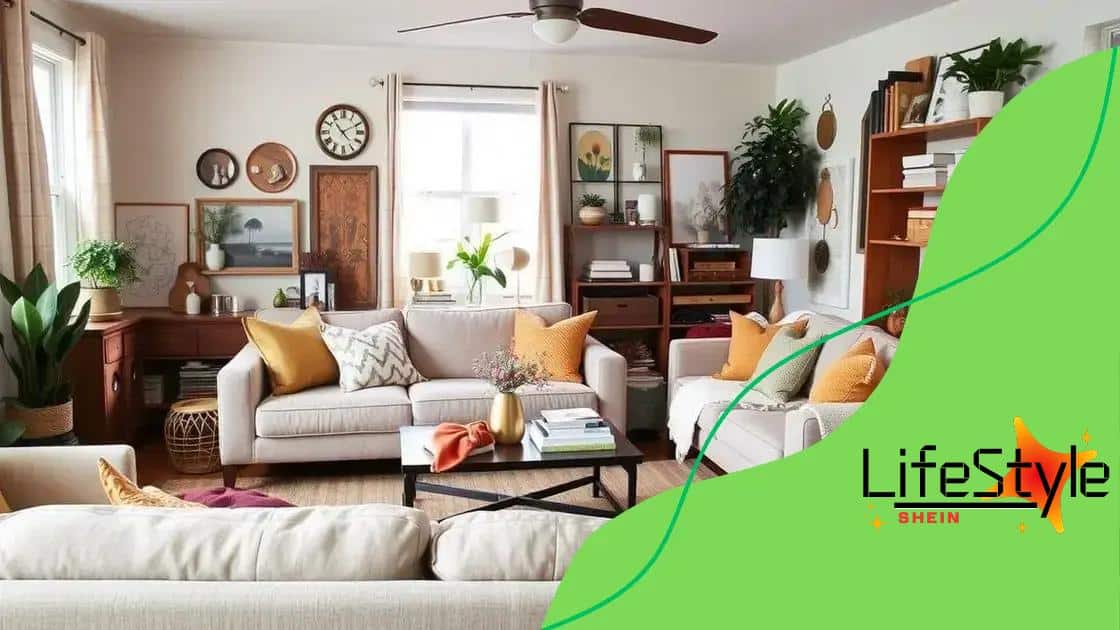The impact of Shein’s home goods on interior design

The impact of Shein’s home goods on interior design includes affordable and trendy options that attract consumers, while raising sustainability and ethical concerns in the fast fashion industry.
The impact of Shein’s home goods on interior design is an evolving conversation. Ever wondered how an online fast-fashion giant is changing your living spaces? Let’s explore this intriguing shift.
How Shein is disrupting the home goods market
How Shein is disrupting the home goods market is an essential topic that reflects current trends in the retail industry. With its unique business model and vast product range, Shein has become a powerhouse in the home goods sector.
One of the key aspects of Shein’s success is its ability to offer a wide variety of affordable yet stylish products. This has made home decor accessible to many people who may not have considered redecorating before. The influx of trendy items promotes a new lifestyle where consumers can frequently refresh their living spaces.
Affordable Trends
Shein’s competitive pricing strategy is a game changer. Many consumers are looking for affordable options without sacrificing style. By providing on-trend products, Shein has embraced a new concept of retailing, focusing on customer satisfaction with every purchase.
- Frequent new arrivals keep the inventory fresh.
- Competitive pricing attracts budget-conscious consumers.
- Affordable items increase impulse buying.
- Wider selection allows for personal expression.
The marketing strategies used by Shein are also revolutionary. The brand leverages social media influencers to reach a younger audience, creating a community around its products. The user-generated content showcases real-life applications of their home goods, enhancing its appeal. This social proof motivates potential buyers to add items to their carts.
Moreover, Shein’s online presence has shifted how consumers shop for home goods. With a user-friendly platform, customers can easily view thousands of products, making the process enjoyable. Detailed product images and descriptions help consumers make informed choices, demonstrating the importance of transparency in modern retail.
Environmental Considerations
However, it’s important to consider the environmental impact of fast fashion in home goods. While affordability is appealing, the question of sustainability arises. Consumers are increasingly prioritizing eco-friendly options, leading brands to adapt.
Shein’s ability to disrupt the market hinges not only on its stylish offerings but also on its adaptability to consumer needs. As the market evolves, Shein must balance affordability with sustainable practices to maintain its place at the forefront of home decor.
Trends set by Shein home goods
Trends set by Shein home goods reflect a significant shift in how consumers approach home decor. With an ever-changing inventory, Shein introduces fresh styles that inspire creativity and personal expression in interior design.
The bold colors and trendy patterns available from Shein challenge traditional decor choices. As shoppers seek to differentiate their spaces, this brand continuously pushes boundaries, promoting unique combinations that make homes stand out.
Popular Styles from Shein
Some popular trends originating from Shein include:
- Bohemian aesthetics: This style embraces earthy tones, textiles, and layered designs.
- Minimalism: Simple, clean lines create serene environments that enhance functionality.
- Vintage vibes: Retro patterns and designs are making a comeback, appealing to those who love nostalgic touches.
- Eclectic mixes: The art of blending different styles allows homeowners to express their tastes freely.
The influence of Shein extends beyond just products; it shapes the entire shopping experience. Social media platforms, particularly Instagram and TikTok, feature countless influencers showcasing their Shein home decor finds. This visibility creates a sense of urgency and excitement among potential buyers, as they desire to replicate attractive setups seen online.
Additionally, the rapid production cycles lead to seasonal trends being introduced at unprecedented speeds. This means customers can frequently refresh their home decor to match emerging styles. The accessibility of these trends encourages consumers to experiment with their spaces without significant financial investment.
Consumer Influence on Trends
With Shein’s robust online community, customer feedback plays an essential role in shaping trends. Reviews and shared photos help fellow shoppers make informed decisions, contributing to a cycle of popularity. Thus, what starts as a bold new design can quickly become a staple in many homes.
As Shein continues to disrupt the home goods market, it encourages individual creativity while making stylish decor attainable for everyone. The excitement of trying new trends can inspire people to transform their homes in ways they never thought possible.
Impact of affordability in interior design

Impact of affordability in interior design plays a crucial role in shaping how people create their spaces. As home decor becomes more accessible, many individuals can personalize their homes without breaking the bank.
With the rise of affordable brands like Shein, consumers are no longer confined to expensive furnishings. This shift empowers people to experiment with styles, colors, and textures they might not have chosen before. The ease of shopping online also contributes to a wider selection of unique decor options, making it easier to find something that fits personal tastes.
Benefits of Affordable Interior Design
Affordable options provide several key benefits:
- Customization: People can mix and match different styles, creating a space that truly reflects their personality.
- Frequent Upgrades: Lower prices allow homeowners to update their decor more often, keeping their environments fresh.
- Accessibility: More individuals can afford to redecorate, leading to more diverse design choices across different demographics.
- Creative Freedom: With cost not being a major barrier, individuals feel freer to take design risks.
As affordability becomes a focal point, it transforms the interior design landscape. People are more willing to share their design journeys on social media, showcasing their personalized spaces and promoting trends. These shared experiences create a vibrant online community where ideas and inspirations flow freely.
Moreover, the demand for affordable decor encourages brands to innovate. To stay competitive, companies are developing new materials and production methods that offer stylish products at lower prices. This ongoing evolution drives the industry towards more sustainable practices, further enhancing the appeal of affordability in interior design.
Future Implications
The impact of affordability in interior design goes beyond individual choices. As more consumers embrace affordable options, it encourages retail giants to rethink their pricing structures and production strategies. This could lead to a long-term shift in how home goods are designed, marketed, and sold in the future, promoting a more inclusive approach to decorating.
Sustainability issues with Shein products
Sustainability issues with Shein products are becoming increasingly important as consumers become more aware of environmental impacts. While Shein offers trendy and affordable home goods, this raises questions about the long-term sustainability of such a fast-fashion model.
One major concern is the production process. Shein’s rapid turnaround time means items are produced quickly, often leading to less rigorous quality control. This can result in products that do not last long, contributing to waste. The sheer volume of items produced for each trend also raises red flags regarding resource overuse.
Environmental Impact
The environmental footprint of producing cheap goods is significant. Some key points include:
- Water usage: Fast fashion typically requires vast amounts of water for cotton production and dyeing processes.
- Pollution: Factories can emit greenhouse gases and release toxic chemicals into the environment.
- Waste generation: Many consumers dispose of items after a short period, leading to landfill overflow.
- Carbon emissions: The transportation of goods globally adds to the overall carbon footprint.
Moreover, Shein’s supply chain transparency is often lacking, making it difficult for consumers to understand the origins of their purchases. Consumers increasingly expect brands to show how they source materials and treat workers, and this is an area where Shein faces criticism.
Consumer Awareness and Change
As awareness grows, some shoppers are beginning to seek alternatives. They want products made from sustainable materials and ethical labor practices. Brands that prioritize sustainability can gain a competitive edge by aligning with consumers who value these principles.
While some companies strive to adopt eco-friendly practices, it’s crucial for consumers to remain informed. Researching brands and looking for certifications can guide more sustainable choices. This shift in purchasing behavior can push companies like Shein to reconsider their policies and practices.
Consumer responses to Shein’s offerings
Consumer responses to Shein’s offerings have been varied and vocal, reflecting a mix of appreciation and criticism. As Shein grows in popularity, shoppers express both excitement over affordability and concern over ethical practices.
A significant portion of consumers is drawn to Shein for its extensive range of stylish items at low prices. Many users share their positive experiences on social media, highlighting how the brand allows them to keep up with trends without overspending. The ease of shopping online and the thrill of finding unique pieces contribute to a positive perception among younger shoppers.
Positive Feedback
Some common themes in positive consumer responses include:
- Affordability: Customers love the low prices that make decorating accessible.
- Variety: Shein offers a wide range of designs, accommodating different tastes and preferences.
- Trendy Styles: Many consumers appreciate that Shein stays ahead of trends, providing the latest looks.
- User-Friendly Shopping: The website is easy to navigate, enhancing the overall shopping experience.
However, not all responses are positive. Many consumers are increasingly concerned about the sustainability and ethical implications of fast fashion. As they become more aware of the environmental impact and labor conditions associated with production, some shoppers express reluctance to support brands that do not prioritize ethical practices.
Concerns Raised
Critics often voice their thoughts on these important issues:
- Sustainability: Concerns about the environmental cost of producing low-priced goods.
- Quality: Some consumers note that the quality of products can be inconsistent.
- Ethical Practices: There are worries about labor conditions in manufacturing facilities.
- Fast Fashion Cycle: The rapid turnover of trends can lead to a throwaway culture.
These mixed responses indicate that while Shein has successfully captured a large audience, it must continue to adapt. Growing consumer awareness means brands must be transparent and responsible in their practices. The dialogue between the brand and its customers will shape its future direction.
FAQ – Frequently Asked Questions about Shein’s Home Goods
What makes Shein’s home goods so popular?
Shein’s home goods are popular due to their affordability, trendy designs, and the wide variety of options available for consumers.
Are there sustainability concerns with Shein products?
Yes, there are concerns related to environmental impact and ethical practices, as Shein follows a fast fashion model that can contribute to waste and pollution.
How do consumers respond to Shein’s offerings?
Consumer responses are mixed; many appreciate the affordability and trends, while others raise concerns about quality and sustainability.
What should consumers look for when shopping at Shein?
Consumers should consider product quality, sustainability practices, and read reviews to make informed shopping decisions.





